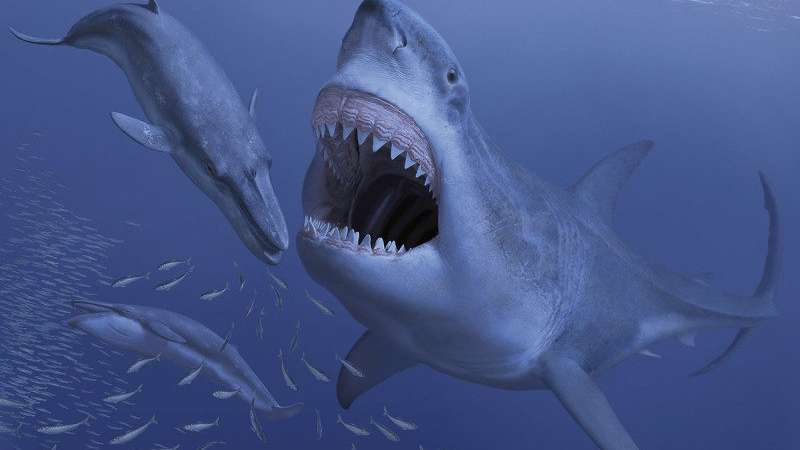Credit: "Did the giant extinct shark Carcharocles megalodon target small prey? Bite marks on marine mammal remains from the late Miocene of Peru" Palaeogeography, Palaeoclimatology, Palaeoecology (2017). DOI: 10.1016/j.palaeo.2017.01.001
(Phys.org)—A team of researchers with members from Italy, Belgium and Peru has found evidence that suggests the reason the giant shark megalodon went extinct millions of years ago, was because its small prey went extinct due to climate change. In their paper published in Palaeogeography, Palaeoclimatology, Palaeoecology, the team describes fossils they found in Peru and their link to the giant ancient shark.
Megalodon lived approximately 17 to 2.6 million years ago, and at least some of the giant sharks grew to over 50 feet long, with jaws 10 feet wide. But why the largest shark to ever swim the world's oceans suddenly went extinct remains a mystery. In this new effort, the researchers report that they have found evidence that the reason might have been that the sharks had a penchant for eating tiny whales, which themselves went extinct due to climate change.
The new evidence came in the form of 7-million-year-old mammalian fossils recently uncovered in southern Peru—they were of a species of dwarf baleen whale and an early relative of a modern seal (both of which grew to only 5 meters long)—both had bite marks that the researchers believe came from a megalodon—the first discovered evidence of a megalodon attack. This, the researchers suggest, indicates that one of megalodons' preferred meal choices was a type of small whale that went extinct, leaving the giant sharks with too little to eat.
Prior research has suggested that the tiny baleen whales went extinct because they were unable to migrate to far-away feeding grounds as the Earth cooled, causing ice build-up at the poles, lower sea levels, and resulting in colder water. Large baleen whales, the ancestors of those alive today, were big enough to migrate for food, but those that were too small to make the trip died out. As the small whales disappeared, the researchers contend, the giant sharks found themselves without a reasonable substitute and unable to migrate themselves; because of that, they died out also.
This newest evidence might just be part of the story, however, as other recent research has suggested that megalodons suffered from competition with white sharks and perhaps killer whales.
More information: Alberto Collareta et al, Did the giant extinct shark Carcharocles megalodon target small prey? Bite marks on marine mammal remains from the late Miocene of Peru, Palaeogeography, Palaeoclimatology, Palaeoecology (2017). DOI: 10.1016/j.palaeo.2017.01.001
Abstract
We report on bite marks incising fossil mammal bones collected from upper Miocene deposits of the Pisco Formation exposed at Aguada de Lomas (southern Peru) and attributed to the giant megatooth shark Carcharocles megalodon. The bitten material includes skull remains referred to small-sized baleen whales as well as fragmentary cetacean and pinniped postcrania. These occurrences, the first in their kind from the Southern Hemisphere, significantly expand the still scarce record of bite marks for C. megalodon; moreover, for the first time a prey (or scavenging item) of C. megalodon is identified at the species level (as Piscobalaena nana, a diminutive member of the extinct mysticete family Cetotheriidae). Due to the fragmentary nature of the studied material, the exact origin of the detected marks (i.e., by scavenging or by active predation) cannot be ascertained. Nevertheless, relying on actualistic observations and size-based considerations, we propose that diminutive mysticetes (e.g., cetotheriids) were some of the target prey of adult C. megalodon, at least along the coast of present-day Peru. C. megalodon is thus here interpreted as an apex predator whose trophic spectrum was focused on relatively small-sized prey. Lastly, we propose a link between the recent collapse of various lineages of diminutive mysticetes (observed around 3 Ma) and the extinction of C. megalodon (occurring around the end of the Pliocene).
Journal information: Palaeogeography, Palaeoclimatology, Palaeoecology
© 2017 Phys.org























